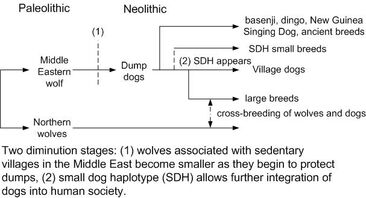
Mankind The Story of All of Us Domesticating the Dog

A timeline that shows the domestication of the dog. This timeline illustrates the length of time it took before the modern dog came about.
In short, domestication is the process of altering a population's genetic structure in order to create organisms whose traits benefit humans. This is done through multiple generations of selective breeding in order to accentuate the desirable traits. Animals that have been domesticated loose the ability to survive by themselves in the wild.
Artifical Selection[]
Domestication utilizes using artifical selection; individuals that possess the desirable traits are choosen to mate with specific partners. This increases the chance of the desirable traits being passed on to following generations.
The End Product[]
An animal is considered to be domesticated when it shows a high tolerance for humans and their close proximity; additionally, their physiology, morphology, and behavior were modified through generations of selective breeding. The tolerance for humans is based on a genetic sense, but not necessarily in the behavior sense (such as a bulls). In the end, multiple traits including those that affect mood, emotion, agnostic and affilative behavior, and social communication has all been changed.
Consequences of Domestication[]
Domestication of plants and animals is considered the "most momentous change in Holocene human history" according to Diamond (2002, p. 700). Although domestication provided us with a plethora of food sources, the process comes with consequences. Some of these drawbacks include allowing people to settle in one place (sedentary living) and greatly increase the human population, which continues today-this can be seen as a consequence as it creates intense competition for resources (Diamond, 2002). Other drawbacks include food surpluses which Diamond states is connected to political centralization and the creation of armies (2002). Infectious disease, spread through the large dense human populations that formed as a result of agricultural practices (Diamond, 2002). Possibly most pertinent to this class is Diamond's mention that domestication of animals has caused evolution of human genes (for example, the evolution of lactose-intolerant people) (Diamond, 2002).
References:
Diamond, J. (2002). Evolution, consequences and future of plant and animal domestication. Nature, 418(6898), 700–707. doi:10.1038/nature01019
Driscoll, C.A., D.W. Macdonald, S.J. O'Brian. (2009). From wild animals to domestic pets, an evolutionary view of domestication. Pro National Academy of Science USA 1:9971-9978.